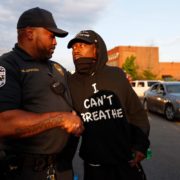By Darcy Costello, Courier-Journal
Louisville Metro Council is considering requiring that officers in “critical incidents,” such as a police shooting, submit to a drug and alcohol test after the incident.
The proposed ordinance, filed Friday, would necessitate a change in police policy to require drug and alcohol testing be performed “as soon as practicable” after incidents that cause death or injury, and no later than the end of the officer’s shift and before any interviews are done.
It calls for any violation to lead to disciplinary action.
Council President David James, D-6th District, who is co-sponsoring the legislation, along with Councilwoman Barbara Sexton Smith, D-4th, said Tuesday that during the conversation around the fatal police shooting of Breonna Taylor, he realized “it wasn’t taking place on the police department.”
Featured Image, Mandy McLaren/Courier Journal
Full article @ Courier-Journal
CONTEXT: Louisville, Kentucky
Louisville is the largest city in the Commonwealth of Kentucky and the 29th most-populous city in the United States. It is one of two cities in Kentucky designated as first-class, the other being Lexington, the state’s second-largest city. Louisville is the historical seat and, since 2003, the nominal seat of Jefferson County, on the Indiana border.
Named after King Louis XVI of France, Louisville was founded in 1778 by George Rogers Clark, making it one of the oldest cities west of the Appalachians. With nearby Falls of the Ohio as the only major obstruction to river traffic between the upper Ohio River and the Gulf of Mexico, the settlement first grew as a portage site. It was the founding city of the Louisville and Nashville Railroad, which grew into a 6,000-mile (9,700 km) system across 13 states.
Today, the city is known as the home of legendary boxer Muhammad Ali, the Kentucky Derby, Kentucky Fried Chicken (KFC), the University of Louisville and its Cardinals, Louisville Slugger baseball bats, and three of Kentucky’s six Fortune 500 companies: Humana, Kindred Healthcare, and Yum! Brands. Muhammad Ali International Airport, Louisville’s main commercial airport, hosts UPS’s worldwide hub.
The 2007 demographic breakdown for the entire Louisville Metro area was 74.8% white (71.7% non-Hispanic), 22.2% black, 0.6% American Indian, 2.0% Asian, 0.1% Hawaiian or Pacific islander, 1.4% other, and 1.6% multiracial. About 2.9% of the total population was identified as Hispanic of any race. During the same year, the area of premerger Louisville consisted 60.1% white, 35.2% African American, 1.9% Asian, 0.2% American Indian, and 3.0% other, with 2.4% identified as Hispanic of any race.
Of the 287,012 households, 29.6% had children under the age of 18 living with them, 45.2% were married couples living together, 14.7% had a female householder with no husband present, and 36.2% were not families. About 30.5% of all households were made up of individuals, and 10.3% had someone living alone who was 65 years of age or older. The average household size was 2.37 and the average family size was 2.97.
The age distribution is 24.3% under the age of 18, 8.9% from 18 to 24, 30.4% from 25 to 44, 22.8% from 45 to 64, and 13.5% who were 65 years of age or older. The median age was 37 years. For every 100 females, there were 91.60 males. For every 100 females age 18 and over, there were 87.60 males.
The median income for a household in 2017 was $51,960. For non-family households the median income was $32,446, and for family households was $67,965. In 2017, males had a median income of $36,326 while females had a median income of $30,464. The latest available data for per capita income comes from 2006, and was $23,304 for the county. About 9.5% of families and 15.1% of the population were below the poverty line in 2017, including 23.5% of those under age 18 and 8.2% of those ages 65 or over.
Louisville, Kentucky. (2020). Retrieved June 26, 2020, from Wikipedia.

